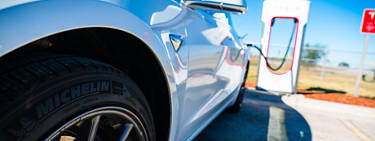Demand for electric vehicles has reached new levels and it’s now quite common to see EVs on highways and neighborhoods alike across the country.
(Live in California? Check out our guide to EV tires in California!)
This growing demand increases the need to understand EV equipment and maintenance. EV tires have key distinctions from traditional tires.
We discuss more below to help you make informed and confident tire purchases. You’ll also be able to help your electric vehicle perform better!
HOW EV TIRES ARE DIFFERENT
When an EV’s original equipment (OE) tires wear out, many drivers wonder, “What tires should I buy for my EV?”
EVs face some unique challenges compared to gas powered cars, also called internal combustion engines (or ICE). Keep these in mind when shopping for your next set so you can stay comfortable, efficient, and safe.
Electric vehicles Vs Gas-powered vehicles | |
Trait | Consequence |
Heavier* | Tires wear faster |
Generate more torque | Requires more traction, increases tire wear, and increases rolling resistance |
Quieter | More in-cabin noise |
Air pressure sensitive | Affects treadwear, efficiency, and safety |
*An EV can weigh up to 1,000 lbs more than a similar sized ICE vehicle
Thanks to their heavy battery packs and increased torque, electric vehicles can chew up tires much faster than a gas-powered vehicle.
Proper air pressure is critical for treadwear, performance and safety. Not only does proper inflation support the weighty EV battery pack, it also plays a key role in maintaining even treadwear and providing predictable steering response. That means you can expect better performance, and better fuel efficiency with properly aired tires.
We asked Klay Donaldson, a 12-year tire industry veteran and our product development manager, for his input on things to consider when researching EV tires.
“Since electric vehicles weigh more than traditional ICE vehicles and also deliver significantly more torque, they tend to experience more aggressive tire wear,” Donaldson said. “This is where monitoring tire pressure becomes even more important for EV drivers, not only to maximize the life of EV tires, but also because air loss increases tire rolling resistance, which can negatively impact battery range.”
TYPES OF ELECTRIC VEHICLES
There are several different types of electric vehicles (EVs).
Sometimes referred to as a battery electric vehicle (BEV), EV is typically used as an umbrella term encompassing a few different vehicle types:
Full battery vehicles (BEV) are powered entirely by electric batteries. Often just referred to as EVs, they require less maintenance than gas vehicles as there are fewer moving parts. They require charging and do not include a backup gas engine. Examples of BEVs include: Kia Niro EV, Tesla Model 3 and Model Y, Hyundai Ioniq 5
Hybrid vehicles (HEV) use both a gas and electric motor to operate. Some HEVs use kinetic energy (called regenerative braking) to charge its battery. The gas powered engine will kick on when the battery is drained. Some hybrids use the battery to power the vehicle below certain speeds and gas at faster speeds (usually 15mph+). Examples of HEVs include: Toyota Prius, Kia Niro and the Hyundai Santa Fe Hybrid
Plug-in hybrid vehicles (PHEV) use both gasoline and an electric motor with a larger battery than an HEV. This allows them to drive further on electricity alone but will still revert back to gas when the charge is gone. As their name suggests, they must be plugged in to recharge. Examples of PHEVs include: BMW 3 Series 330e and Honda Clarity
The biggest incentives to switch to an EV from gas are:
Lowered fuel and commuting costs
Lowered environmental burden
Reduced maintenance (no oil changes, etc.)
Instantaneous torque, peppy performance*
*The Rivian R1T and R1S can go from 0 to 60 mph in 3 seconds, for example.
You can maximize your ride’s efficiency with the right set of tires. Remember: low rolling resistance offers better fuel efficiency.
THE BEST EV SPECIFIC TIRES
Discount Tire strongly recommends driving safely and sensibly for both your safety and the longevity of your tires.
Here are our picks of the best EV tires.
The best tires for your EV are the ones that meet your specific needs. This is true whether you have an electric or gas powered vehicle. Your tire should match your vehicle, driving conditions, budget, and preferences.
The best EV specific tires:
Extend tread life
Reduce noise
Increase range/fuel efficiency
Offer excellent traction
Are robust
Generally speaking, the OE brand and model tires that came with your EV are a great replacement option because they were specifically chosen by the vehicle manufacturer to work with your model. If you like the way your vehicle handles off the lot, the original equipment tires are a good pick.
If you want to optimize your vehicle’s performance (either increasing efficiency, better handling, etc.), aftermarket options may be your best bet.
What EV tires do I need?
Get a custom EV tire buying experience for your EV with Treadwell.
Treadwell is our online tire buying tool that pairs you with the best tires for you, your vehicle, and your region. Using real world test results and actual driver experience, it delivers only the best match to you with a few easy steps. Results are conducted by an unbiased and credible 3rd party from rigorous, Olympic-level product testing.
Even better: Treadwell incorporates EV specific concerns, like battery range, in its search so you can see tires that fit your exact needs.
Ready to roll?
Do you still need help or want to get started on some new tires? Give us a ring, stop on by, or make an appointment and we’ll get you taken care of. Buy and book online to save time!
For more information on this and other tire and wheel services, check out our YouTube Channel or reach out to us on X, Facebook and Instagram.
Want to see recommendations for you and your vehicle on the Discount Tire blog? Fill out this form!
